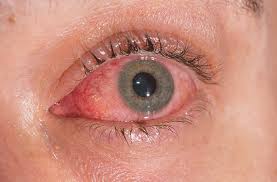Pink eye, also known as conjunctivitis, is one of the most common eye conditions, affecting millions of people around the world every year. It is an inflammation or infection of the conjunctiva, the thin membrane that lines the inside of the eyelids and covers the white part of the eyeball. While pink eye is often associated with children, anyone can develop this condition, regardless of age. The causes of pink eye can range from viral infections to allergic reactions, and though it is often mild, it can sometimes lead to more serious complications if left untreated.

What is Pink Eye (Conjunctivitis)?
Pink eye, or conjunctivitis, is an inflammation of the conjunctiva—the clear tissue that covers the white part of your eye and lines the inside of your eyelids. When this tissue becomes irritated, it causes the blood vessels to dilate, resulting in the characteristic red or pink appearance of the eye. In most cases, pink eye is not serious and can be treated effectively with proper care. However, some cases of pink eye can be caused by more serious infections or conditions that require medical attention.
How is Pink Eye Formed?
Pink eye happens when something — be it a virus, bacteria, allergen, or irritant — messes with the delicate tissues of your conjunctiva. Your body’s immune system responds by flooding the area with inflammation and white blood cells, which causes the blood vessels in your eyes to swell and become more visible, giving your eye that lovely red or pink hue.
Types of Pink Eye
There are several types of pink eye, each with distinct causes and characteristics. The three most common types are:
- Viral Conjunctivitis:
- This type is caused by viruses, often those responsible for the common cold, such as adenovirus. Viral conjunctivitis is highly contagious and usually spreads through contact with respiratory droplets or contaminated surfaces.
- Symptoms: Watery discharge, redness in the eye, itching or irritation, and sometimes sensitivity to light. It often begins in one eye but can spread to the other eye.
- Bacterial Conjunctivitis:
- This form of conjunctivitis is caused by bacteria, such as Staphylococcus aureus or Streptococcus pneumoniae, and is also highly contagious. It can occur when bacteria from the skin or respiratory tract infect the eye.
- Symptoms: Thick, yellow-green discharge from the eye, crusting on the eyelids, and irritation. Bacterial pink eye may also be associated with swelling of the eyelids and conjunctiva.
- Allergic Conjunctivitis:
- Allergic conjunctivitis occurs when the eyes react to allergens like pollen, dust mites, or pet dander. Unlike viral and bacterial conjunctivitis, allergic pink eye is not contagious.
- Symptoms: Red, itchy eyes, watery discharge, and swelling around the eyes, often accompanied by other allergy symptoms such as sneezing or a runny nose.
- Irritant Conjunctivitis:
- This type of pink eye results from chemical irritants, such as smoke, chlorine in swimming pools, or exposure to fumes and dust. It can also be caused by foreign objects in the eye, such as makeup or contact lenses.
- Symptoms: Redness, irritation, and watering of the eyes, often with a gritty feeling or discomfort.
Symptoms and Causes
What are the symptoms of pink eye?
The symptoms of pink eye can vary based on the type of infection or irritant involved, but common signs include:
- Redness in the white part of the eye.
- Itchy or gritty feeling in the eyes.
- Watery or thick discharge that may cause crusting on the eyelids, especially after sleeping.
- Swelling of the eyelids and conjunctiva (the tissue lining the eye).
- Increased tear production (tearing).
- Sensitivity to light (photophobia).
- Blurred vision in some cases (usually when there is a significant discharge).
While viral and bacterial pink eye can be highly contagious, allergic conjunctivitis is not contagious and often occurs in response to seasonal allergens.
What causes pink eye?
The primary causes of pink eye include:
Foreign bodies or contact lenses: Wearing dirty contact lenses or having a foreign object in the eye can lead to irritation and infection.
Viral infections: Most commonly caused by adenoviruses, which can spread easily in places like schools and daycare centers.
Bacterial infections: Often spread by direct contact with infected individuals, or by touching contaminated objects (e.g., towels, pillowcases).
Allergic reactions: Caused by allergens like pollen, dust, or pet dander.
Chemical irritants: Exposure to smoke, chlorine, or air pollution can irritate the eyes and lead to conjunctivitis.
Symptoms of Pink Eye
The symptoms of pink eye can vary based on the type of infection or irritant involved, but common signs include:
- Redness in the white part of the eye.
- Itchy or gritty feeling in the eyes.
- Watery or thick discharge that may cause crusting on the eyelids, especially after sleeping.
- Swelling of the eyelids and conjunctiva (the tissue lining the eye).
- Increased tear production (tearing).
- Sensitivity to light (photophobia).
- Blurred vision in some cases (usually when there is a significant discharge).
While viral and bacterial pink eye can be highly contagious, allergic conjunctivitis is not contagious and often occurs in response to seasonal allergens.
What are the risk factors for conjunctivitis?
Understanding the risk factors for pink eye can help you take steps to protect your eyes and avoid unnecessary eye drama. So, if you’re looking to keep your eyes safe from the red-eye blues, here’s what you need to know about the risk factors behind pink eye.
- Close Contact with Infected Individuals
- Poor Hygiene Practices
- Contact Lenses
- Allergies (When Your Body Overreacts)
- Chronic Eye Conditions (A Long-Term Risk)
- Environmental Factors (Smoke, Pollution, and More)
- Underlying Health Conditions (Weak Immune System)
- Age
- Contaminated Cosmetics
Is conjunctivitis preventable?
Preventing pink eye largely depends on its underlying cause. Here are some general strategies to reduce your risk:
- Practice good hygiene: Wash your hands frequently, especially after touching your eyes, nose, or mouth. Avoid touching your face, and use tissues to wipe away any eye discharge.
- Avoid sharing personal items: Do not share towels, pillowcases, makeup, or eye makeup with others, as these can spread infections.
- Stay away from infected individuals: If someone has viral or bacterial pink eye, avoid close contact with them to reduce the risk of transmission.
- Keep your environment clean: Disinfect surfaces and items like door handles, remote controls, and other shared items that could be contaminated.
- Manage allergies: If you are prone to allergic conjunctivitis, try to minimize exposure to allergens. Use air purifiers and wash your hands after touching potential allergens.
- Proper contact lens hygiene: Clean your contact lenses properly and avoid wearing them for too long to reduce the risk of irritation and infection.
Stem Cell Therapy for Pink Eye

While most cases of pink eye can be treated with over-the-counter remedies or prescribed antibiotics (in the case of bacterial infections), stem cell therapy is emerging as a potential treatment for more severe or chronic eye conditions, including persistent forms of conjunctivitis or damage caused by the infection.
Stem cells have the unique ability to regenerate and repair damaged tissue, making them a promising option for treating persistent or complicated cases of pink eye, particularly those involving corneal damage or chronic inflammation. Research into the use of stem cells in eye care is still ongoing, but early studies show potential in using stem cells to promote healing and restore function to the eye’s surface.
STEM CELL TREATMENT for Pink Eye
Spidex12 is an innovative treatment that has shown promise in addressing chronic or severe cases of conjunctivitis. Spidex12 is a biologic therapy designed to target and reduce the underlying inflammation associated with both viral and bacterial pink eye. This treatment is aimed at improving the healing process and reducing the risk of complications, such as scarring or persistent inflammation.
Spidex12 works by modulating the immune response, helping to calm the inflammation in the conjunctiva while supporting the body’s natural healing processes. It is especially useful for individuals suffering from recurrent or severe cases of pink eye that do not respond well to conventional treatments.
The therapy is designed to be both effective and minimally invasive, providing an alternative to the long-term use of antibiotics or corticosteroids. Early clinical trials have shown that Spidex12 can help reduce symptoms such as redness, swelling, and discomfort, while promoting faster healing in patients with pink eye.
Conclusion
Pink eye, or conjunctivitis, is a widespread condition that can result from infections, allergies, or irritants. Although it is often mild and resolves with basic treatment, more severe cases or recurrent infections can lead to complications. By understanding the different types of pink eye, their causes, and symptoms, individuals can better manage the condition and seek appropriate treatment when necessary.
Innovative treatments like Spidex12 offer promising solutions for those with chronic or persistent pink eye, providing a new approach to reducing inflammation and speeding up the healing process. If you are dealing with pink eye, it’s important to consult a healthcare provider to determine the most effective treatment options for your specific condition.
With advancements in biologic therapies and ongoing research into stem cell treatments, the future looks bright for those seeking relief from the discomfort and potential complications of pink eye.



